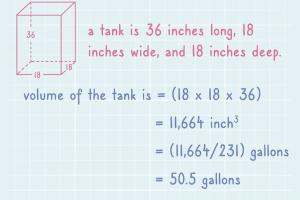Unlocking the Secrets: A Comprehensive Guide on How to Figure Out How Many Gallons in a Tank

-
Quick Links:
- Introduction
- Understanding Tank Volume
- What is a Gallon?
- Common Types of Tanks
- Calculating Gallons in a Tank
- Formulas for Different Tank Shapes
- Step-by-Step Guide
- Case Studies
- Expert Insights
- FAQs
Introduction
Calculating the capacity of a tank can seem daunting, but it’s an essential skill for anyone who works with water, fuel, or other liquids. Whether you’re trying to fill a swimming pool, fuel a vehicle, or manage a fish tank, knowing how to figure out how many gallons are in a tank is crucial. This comprehensive guide will walk you through the various methods, formulas, and considerations for accurately measuring liquid volume in different types of tanks.
Understanding Tank Volume
Volume refers to the amount of space that a substance (in this case, liquid) occupies. The measurement of volume can be done in various units, but gallons are one of the most commonly used for liquid measurement in the U.S. Understanding how to measure the volume of a tank will help you determine how many gallons it can hold.
What is a Gallon?
A gallon is a unit of volume commonly used in the United States customary and imperial systems. One U.S. gallon is equivalent to 3.785 liters. Understanding this conversion is vital when you need to switch between units or when you’re dealing with tank capacities in different formats.
Common Types of Tanks
- Water Tanks
- Fuel Tanks
- Fish Tanks
- Aquarium Tanks
- Storage Tanks
- Septic Tanks
Calculating Gallons in a Tank
The process of calculating the volume in gallons depends on the shape of the tank. Here, we’ll cover the most common tank shapes, including rectangular, cylindrical, and spherical tanks.
Formulas for Different Tank Shapes
Rectangular Tanks
For a rectangular tank, the formula to calculate the volume in gallons is:
Volume (gallons) = Length (ft) x Width (ft) x Height (ft) x 7.48
Cylindrical Tanks
For cylindrical tanks, the formula is:
Volume (gallons) = π x (Radius (ft) x Radius (ft)) x Height (ft) x 7.48
Spherical Tanks
For spherical tanks, the formula is:
Volume (gallons) = (4/3) x π x (Radius (ft) x Radius (ft) x Radius (ft)) x 7.48
Step-by-Step Guide
- Identify the shape of your tank.
- Measure the necessary dimensions (length, width, height, and radius as applicable).
- Insert the measurements into the appropriate formula.
- Calculate the volume and convert to gallons if necessary.
Case Studies
Let’s explore a couple of real-world scenarios:
Case Study 1: Filling a Swimming Pool
Suppose you have a rectangular swimming pool that is 20 feet long, 10 feet wide, and 4 feet deep. Using the formula for a rectangular tank:
Volume = 20 ft x 10 ft x 4 ft x 7.48 = 5,976 gallons
Case Study 2: Fuel Tank Calculation
For a cylindrical fuel tank with a radius of 3 feet and a height of 10 feet:
Volume = π x (3 ft x 3 ft) x 10 ft x 7.48 ≈ 211.7 gallons
Expert Insights
According to industry experts, understanding the capacity of your tanks can lead to better maintenance and usage efficiency. Regular checks and calculations can prevent overflows and ensure optimal operation.
FAQs
- 1. How do I convert liters to gallons?
- To convert liters to gallons, divide the number of liters by 3.785.
- 2. Can I use a measuring tape to calculate tank dimensions?
- Yes, a measuring tape is the most accurate way to measure the dimensions of your tank.
- 3. What is the difference between U.S. and imperial gallons?
- One imperial gallon is approximately 1.2 U.S. gallons.
- 4. Why is it important to know the tank capacity?
- Knowing the tank capacity helps prevent overfilling, ensures efficient use, and aids in maintenance planning.
- 5. Are there any online calculators for tank volume?
- Yes, many websites offer free calculators to help you determine tank volume by entering dimensions.
- 6. What if I have an irregularly shaped tank?
- You may need to break it down into smaller, regular shapes and calculate each volume separately.
- 7. How can I measure a tank that is already filled?
- You can use a dipstick method or a float gauge to measure the liquid level and calculate the volume accordingly.
- 8. Is there a simple way to remember the formulas?
- Creating a mnemonic or a quick reference guide can help you remember the formulas for each shape.
- 9. Can I use these formulas for tanks of any size?
- Yes, these formulas are applicable for any size tank, as long as you measure accurately.
- 10. What are some common mistakes in calculating tank volume?
- Common mistakes include incorrect measurements, miscalculating the units, and not converting to gallons correctly.
Random Reads
- How to remove mold mildew front loading washer gasket
- How to access a blocked email account
- How to log into skype
- How to lock safesearch on google
- Safely clean laptop screen household products
- Mastering excel grouping outlining data
- How to get drake sword dark souls
- How to remove mastic
- How to remove marker from wood
- How to enable inspect element microsoft edge